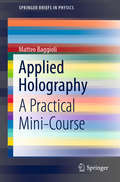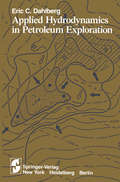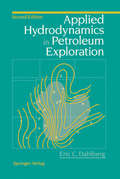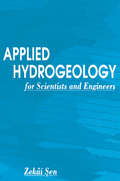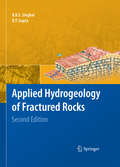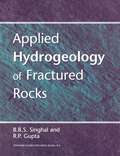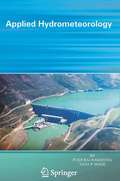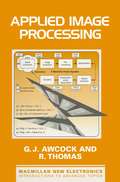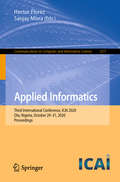- Table View
- List View
Applied Holography: A Practical Mini-Course (SpringerBriefs in Physics)
by Matteo BaggioliThis primer is a collection of notes based on lectures that were originally given at IIT Madras (India) and at IFT Madrid (Spain). It is a concise and pragmatic course on applied holography focusing on the basic analytic and numerical techniques involved. The presented lectures are not intended to provide all the fundamental theoretical background, which can be found in the available literature, but they concentrate on concrete applications of AdS/CFT to hydrodynamics, quantum chromodynamics and condensed matter. The idea is to accompany the reader step by step through the various benchmark examples with a classmate attitude, providing details for the computations and open-source numerical codes in Mathematica, and sharing simple tricks and warnings collected during the author’s research experience. At the end of this path, the reader will be in possess of all the fundamental skills and tools to learn by him/herself more advanced techniques and to produce independent and novel research in the field.
Applied Hydraulic Transients
by M. Hanif ChaudhryApplied Hydraulic Transients, 3rd Edition covers hydraulic transients in a comprehensive and systematic manner from introduction to advanced level and presents various methods of analysis for computer solution. The book is suitable as a textbook for senior-level undergraduate and graduate students as well as a reference for practicing engineers and researchers. The field of application of the book is very broad and diverse and covers areas such as hydroelectric projects, pumped storage schemes, water-supply systems, cooling-water systems, oil pipelines and industrial piping systems. A strong emphasis is given to practical applications: several case studies, problems of applied nature, and design criteria are included. This will help the design engineers and introduce the students to real-life projects. Up-to-date references are included at the end of each chapter.
Applied Hydro-Aeromechanics in Oil and Gas Drilling
by Eugeniy G. Leonov Valeriy I. IsaevAn all-in-one reference combining hydrodynamic theory with drilling applications for the design, planning, and optimization of drilling operations Hydromechanical processes underlie the majority of technology operations in drilling and present a crucial concern as the pace and depth of drilling increasesin today's energy-hungry world. Applied Hydro-aeromechanics in Oil and Gas Drilling offers a unique resource for properly modeling and understanding the hydro-dynamic forces affecting a drilling site. Combining hydrodynamic theory with specific drilling applications, this coverage provides readers with a comprehensive reference for designing, planning, and optimizing drilling operations. Featuring the latest technologies and developments affecting the field, Applied Hydro-aeromechanics in Oil and Gas Drilling covers topics including: The physics of hydro-aeromechanical phenomena in drilling processes Calculation methods for understanding and designing circulation systems for the washing, blasting, and cementing of wells Problems of interaction between wells and reservoirs Problems with the fluid, gas, and liquid-gas mixture flows necessary in designing and building of wells Presenting an unmatched combination of theory, modeling issues, and concrete, illustrative examples, Applied Hydro-aeromechanics in Oil and Gas Drilling bringstogether formerly widespread technical information to offer a systematic and methodical guide. It is an essential reference for both students and researchers studying fluid mechanics, as well as engineers and other professionals working in the oil and gas industry.
Applied Hydro-Aeromechanics in Oil and Gas Drilling
by Eugeniy G. Leonov Valeriy I. IsaevAn all-in-one reference combining hydrodynamic theory with drilling applications for the design, planning, and optimization of drilling operations Hydromechanical processes underlie the majority of technology operations in drilling and present a crucial concern as the pace and depth of drilling increasesin today's energy-hungry world. Applied Hydro-aeromechanics in Oil and Gas Drilling offers a unique resource for properly modeling and understanding the hydro-dynamic forces affecting a drilling site. Combining hydrodynamic theory with specific drilling applications, this coverage provides readers with a comprehensive reference for designing, planning, and optimizing drilling operations. Featuring the latest technologies and developments affecting the field, Applied Hydro-aeromechanics in Oil and Gas Drilling covers topics including: The physics of hydro-aeromechanical phenomena in drilling processes Calculation methods for understanding and designing circulation systems for the washing, blasting, and cementing of wells Problems of interaction between wells and reservoirs Problems with the fluid, gas, and liquid-gas mixture flows necessary in designing and building of wells Presenting an unmatched combination of theory, modeling issues, and concrete, illustrative examples, Applied Hydro-aeromechanics in Oil and Gas Drilling bringstogether formerly widespread technical information to offer a systematic and methodical guide. It is an essential reference for both students and researchers studying fluid mechanics, as well as engineers and other professionals working in the oil and gas industry.
Applied Hydrodynamics: An Introduction to Ideal and Real Fluid Flows
by Hubert ChansonFluid dynamics is the engineering science dealing with forces and energies generated by fluids in motion. Fluid dynamics and hydrodynamics play a vital role in everyday life. Practical examples include the flow motion in the kitchen sink, the exhaust fan above the stove, and the air conditioning system in our home. When driving a car, the air flow
Applied Hydrodynamics: An Introduction
by Hubert ChansonThis textbook treats Hydro- and Fluid Dynamics, the engineering science dealing with forces and energies generated by fluids in motion, playing a vital role in everyday life. Practical examples include the flow motion in the kitchen sink, the exhaust fan above the stove, and the air conditioning system in our home. When driving a car, the air flow
Applied Hydrodynamics in Petroleum Exploration
by E. C. DahlbergIt has for some time been the author's opinion that the need exists for a complete, self-contained volume on hydrodynamics addressed to and written in an idiom for geologists and geophysicists actively engaged in the search for hydrocarbons. This book is offered as my attempt to satisfy this need. Explorationists traditionally concern themselves with four basic aspects of oil and gas occurrence, since these constitute the necessary con ditions enhancing the likelihood of subsurface hydrocarbon accumula tions. They are: Trap, Reservoir, Source, and the Fluids themselves. His torically, great attention has been paid to traps and reservoirs, and much pertinent literature on structure, stratigraphy and lithology is available. With respect to sources, an increasing body of literature is becoming avail able in the form of articles, books and research reports in the areas of geochemistry and mineralogy. It is to the largely ignored fourth aspect, the fluids, that this book is directed. In its formulation I have drawn from numerous sources: college physics texts ("hydrodynamics is one of the most difficult subjects in physics"), personal notes from a rigorous two-week course presented by M. K. Hub bert (who literally fathered the discipline), journal articles (some strong and others weak in their treatment of the subject), discussions with expe rienced exploration geologists (some of whom have successfully utilized these procedures and others who were not so sure), and experience gained as well as mistakes made in the course of my own personal oil and gas exploration activities.
Applied Hydrodynamics in Petroleum Exploration
by Eric C. DahlbergIn the first edition of this book, we observed that it had been created to fill a need for a usable "self-contained volume on hydrodynamics" (and hydrogeology) that was written specifically for the petroleum industry, but could also serve the earth science community in general. When the first edition was published (1982), M. K. Hubbert, the father of petroleum hydrodynamics, was approaching the final stages of his very productive career. For this reason, the book served as a vehicle to amplify his concepts and spread and stimulate applications of some of his theories and methods throughout the exploration sectors of the petroleum industry. This was accomplished by blending discussions of Hubbert's concepts with some of the procedures used by industry specialists to answer practical oil and gas questions. The simple aim of the book was to bring this material to the fingertips of working geologists and geophysicists, who were "evaluating the hydrocarbon possibilities in larger exploration regions or assessing the potential of small, local subsurface oil and gas prospects. " It was also hoped that by treating areas of conceptual overlap between petroleum geology and ground water hydrology, workers in both disciplines would be brought into closer contact, resulting in mutual benefits gained through healthy scientific and technical interaction. This remains our objective in the second edition, although it has become apparent that additional material is needed to satisfactorily achieve it. The size of this volume reflects the new subject matter.
Applied Hydrogeology for Scientists and Engineers
by Zekai SenIn order to properly plan, design, and operate groundwater resources projects, it is necessary to measure - over time or distance - pertinent groundwater variables such as drawdown and discharge in the field. Applied Hydrogeology for Scientists and Engineers shows how to assess and interpret these data by subsurface geological setup and processing. The book helps readers estimate relevant groundwater parameters such as storativity, transmissivity, and leakage coefficient.The text addresses many interrelated disciplines such as geology, hydrology, hydrogeology, engineering, petroleum geology, and water engineering. Traditional and current models for application are presented. One of the unique features of the book is the inclusion of new and previously unpublished ideas, concepts, techniques, approaches, and procedures developed by the author. Among these are hydrogeophysical concepts, slope matching techniques, volumetric approach solution for complicated groundwater flows, non-Darcian flow law applications, aquifer sample functions, dimensionless-type straight line methods, non-linear flow-type curves, discharge calculations from early time-drawdown data, storage coefficient estimation procedure for quasi-steady state flow, and much more. The pitfalls in aquifer test analysis are also detailed. Fractured medium flow adds yet another dimension to the book. Each method is supplemented by actual field data applications from worldwide case studies.Applied Hydrogeology for Scientists and Engineers covers the topics of groundwater reservoirs, the evaluation of aquifer parameters, aquifer and flow properties, flow properties and bore hole tests, aquifer tests in porous and fractured media, well hydraulics, groundwater flow and aquifer tests, and field measurements and their interpretations.This new reference also works well as a post-graduate textbook on the subject. Applied Hydrogeology for Scientists and Engineers expands the reader's knowledge by providing valuable information not found in any other publication.
Applied Hydrogeology for Scientists and Engineers
by Zekai SenIn order to properly plan, design, and operate groundwater resources projects, it is necessary to measure - over time or distance - pertinent groundwater variables such as drawdown and discharge in the field. Applied Hydrogeology for Scientists and Engineers shows how to assess and interpret these data by subsurface geological setup and processing. The book helps readers estimate relevant groundwater parameters such as storativity, transmissivity, and leakage coefficient.The text addresses many interrelated disciplines such as geology, hydrology, hydrogeology, engineering, petroleum geology, and water engineering. Traditional and current models for application are presented. One of the unique features of the book is the inclusion of new and previously unpublished ideas, concepts, techniques, approaches, and procedures developed by the author. Among these are hydrogeophysical concepts, slope matching techniques, volumetric approach solution for complicated groundwater flows, non-Darcian flow law applications, aquifer sample functions, dimensionless-type straight line methods, non-linear flow-type curves, discharge calculations from early time-drawdown data, storage coefficient estimation procedure for quasi-steady state flow, and much more. The pitfalls in aquifer test analysis are also detailed. Fractured medium flow adds yet another dimension to the book. Each method is supplemented by actual field data applications from worldwide case studies.Applied Hydrogeology for Scientists and Engineers covers the topics of groundwater reservoirs, the evaluation of aquifer parameters, aquifer and flow properties, flow properties and bore hole tests, aquifer tests in porous and fractured media, well hydraulics, groundwater flow and aquifer tests, and field measurements and their interpretations.This new reference also works well as a post-graduate textbook on the subject. Applied Hydrogeology for Scientists and Engineers expands the reader's knowledge by providing valuable information not found in any other publication.
Applied Hydrogeology of Fractured Rocks: Second Edition
by B.B.S. Singhal † R.P. GuptaHydrogeology is a topical and growing subject as the earth's water resources become scarcer and more vulnerable. More than half of the surface area of continents is covered with hard rocks of low permiability. This book deals comprehensively with the fundamental principles for understanding the hydrogeological characteristics of rocks, as well as exploration techniques and assessment. It also provides in depth discussion on structural mapping, remote sensing, geophysical exploration, GIS, groundwater flow modelling and contaminant transport, field hydraulic testing including tracer tests, groundwater quality, geothermal reservoirs, managed aquifer recharge, and resources assessment and management. Hydrogeological aspects of various lithology groups, including crystalline rocks, volcanic rocks, carbonate rocks and clastic formations have been dealt with separately, using and discussing examples from all over the world. It will be an invaluable text book cum reference source for postgraduate students, researchers, exploration scientists and engineers engaged in the field of groundwater development in fractured rocks. Applied Hydrogeology of Fractured Rocks - Second Edition is thoroughly revised and extended with a new chapter, updated sections, many new examples, and expanded and updated references.
Applied Hydrogeology of Fractured Rocks
by B.B.S. Singhal † R.P. GuptaHydrology is a topical and growing subject, as the earth's water resources become scarcer and more vulnerable. Although more than half the surface area of continents is covered with hard fractured rocks, there has until now been no single book available dealing specifically with fractured rock hydrogeology. This book deals comprehensively with the fundamental principles for understanding these rocks, as well as with exploration techniques and assessment. It also provides in-depth discussion of structural mapping, remote sensing, geophysical exploration, GIS, field hydraulic testing, groundwater quality and contamination, geothermal reservoirs, and resources assessment and management. Hydrogeological aspects of various lithology groups, including crystalline rocks, volcanic rocks, carbonate rocks and clastic formations, are dealt with separately, using and discussing examples from all over the world. Applied Hydrogeology of Fractured Rocks will be an invaluable reference source for postgraduate students, researchers, exploration scientists, and engineers engaged in the field of groundwater development in fractured rock areas.
Applied Hydrometeorology
by Pukhraj Rakhecha Vijay P. SinghWater is vital for life. Since the dawn of civilization, much effort has been made to harness sources of fresh water. Recent years have raised global awareness of the need for increasing demand of water worldwide, largely because of growing population, rising standard of living, higher demand for energy, and greater appreciation for environmental quality. As an example, the world population has increased threefold in the past five decades. In order to meet the rising water demand, water resources are being developed by building large dams, reservoirs, barrages and weirs across rivers worldwide. The guiding principle for water resources development has been to ensure adequate supply of water for agriculture, domestic use (including fine drinking water), waste disposal, industries, and energy production, with due attention to maintain the ecosystem functions. This development, however, depends on a holistic, cooperative and scientific approach. The basic inputs in the assessment of water resources for a given region are from hydrological data and the subject of hydrology forms the core in achieving sustainable development of water resources. Barring a few exceptions, hydrological data for most river basins are sparse and therefore it is difficult to comprehensively assess their water resources. The major source of water is rainfall which occurs as a result of condensation of atmospheric moisture governed by the science of meteorology.
Applied Image Processing
by Graeme Awcock Ray ThomasWritten from an engineering perspective, this book incorporates a thorough theoretical introduction to the underlying disciplines via its treatment of a generic machine vision system model. Dedicated chapters introduce image acquisition techniques matched to constrained environments, image processing, segmentation, feature extraction, pattern classification (including neural approaches) and interpreting two- dimensional views of the three-dimensional world. It is richly illustrated with case studies of image processing in a wide range of application domains.
Applied Industrial Energy and Environmental Management (Wiley - IEEE #2)
by Zoran Morvay Dušan GvozdenacIndustrial energy systems channel fuels and power into a variety of energy types such as steam, direct heat, hot fluids and gases, and shaft power for compressors, fans, pumps, and other machine-driven equipment. All of these processes impact the environment and are impacted by external energy and environmental policies and regulations. Therefore many environmental management issues are closely related to energy use and efficiency. Applied Industrial Energy and Environmental Management provides a comprehensive and application oriented approach to the technical and managerial challenges of efficient energy performance in industrial plants. Written by leading practitioners in the field with extensive experience of working with development banks, international aid organizations, and multinational companies, the authors are able to offer real case studies as a basis to their method. The book is divided into three main parts: Part one describes Energy and Environmental Management Systems (EEMS) in current use and management techniques for energy and environmental performance improvement. Part two focuses on the engineering aspects of industrial energy management, describing main industrial energy systems and how to analyse and improve their energy performance. Part three is the TOOLBOX on an accompanying website, which contains data, analytical methods and questionnaires as well as software programs, to support the practical application of the methods elaborated on in the first two parts of the book. This book will be a valuable resource to practising energy and environmental management engineers, plant managers and consultants in the energy and manufacturing industries. It will also be of interest to graduate engineering and science students taking courses in industrial energy and environmental management
Applied Informatics: Second International Conference, ICAI 2019, Madrid, Spain, November 7–9, 2019, Proceedings (Communications in Computer and Information Science #1051)
by Hector Florez Marcelo Leon Jose Maria Diaz-Nafria Simone BelliThis book constitutes the thoroughly refereed papers of the Second International Conference on Applied Informatics, ICAI 2019, held in Madrid, Spain, in November 2019.The 37 full papers and one short paper were carefully reviewed and selected from 98 submissions. The papers are organized in topical sections on bioinformatics; data analysis; decision systems; health care information systems; IT Architectures; learning management systems; robotic autonomy; security services; socio-technical systems; software design engineering.
Applied Informatics: Fourth International Conference, ICAI 2021, Buenos Aires, Argentina, October 28–30, 2021, Proceedings (Communications in Computer and Information Science #1455)
by Hector Florez Ma Florencia Pollo-CattaneoThis book constitutes the thoroughly refereed papers of the 4th International Conference on Applied Informatics, ICAI 2021, held in Buenos Aires, Argentina, in October, 2021.The 35 full papers were carefully reviewed and selected from 89 submissions. The papers are organized in topical sections on artificial intelligence; data analysis; decision systems; health care information systems; image processing; security services; simulation and emulation; smart cities; software and systems modeling; software design engineering.
Applied Informatics: Third International Conference, ICAI 2020, Ota, Nigeria, October 29–31, 2020, Proceedings (Communications in Computer and Information Science #1277)
by Hector Florez Sanjay MisraThis book constitutes the thoroughly refereed papers of the Second International Conference on Applied Informatics, ICAI 2020, held in Ota, Nigeria, in October 2020. The 35 full papers were carefully reviewed and selected from 101 submissions. The papers are organized in topical sections on artificial intelligence; business process management; cloud computing; data analysis; decision systems; health care information systems; human-computer interaction; image processing; learning management systems; software design engineering.
Applied Informatics and Cybernetics in Intelligent Systems: Proceedings of the 9th Computer Science On-line Conference 2020, Volume 3 (Advances in Intelligent Systems and Computing #1226)
by Radek SilhavyThis book gathers the refereed proceedings of the Applied Informatics and Cybernetics in Intelligent Systems Section of the 9th Computer Science On-line Conference 2020 (CSOC 2020), held on-line in April 2020. Modern cybernetics and computer engineering in connection with intelligent systems are an essential aspect of ongoing research. This book addresses these topics, together with automation and control theory, cybernetic applications, and the latest research trends.
Applied Information Processing Systems: Proceedings of ICCET 2021 (Advances in Intelligent Systems and Computing #1354)
by Brijesh Iyer Debashis Ghosh Valentina Emilia BalasThis book is a collection of selected high-quality research papers presented at the International Conference on Computing in Engineering and Technology (ICCET 2021), organized by Dr. Babasaheb Ambedkar Technological University, Lonere, India, during January 30–31, 2021. Focusing on frontier topics and next-generation technologies, it presents original and innovative research from academics, scientists, students and engineers alike. The theme of the conference is Applied Information Processing System.
Applied Information Science, Engineering and Technology: Selected Topics from the Field of Production Information Engineering and IT for Manufacturing: Theory and Practice (Topics in Intelligent Engineering and Informatics #7)
by Gabriella Bognár Tibor TóthThe objective of the book is to give a selection from the papers, which summarize several important results obtained within the framework of the József Hatvany Doctoral School operating at the University of Miskolc, Hungary. In accordance with the three main research areas of the Doctoral School established for Information Science, Engineering and Technology, the papers can be classified into three groups. They are as follows: (1) Applied Computational Science; (2) Production Information Engineering (IT for Manufacturing included); (3) Material Stream Systems and IT for Logistics. As regards the first area, some papers deal with special issues of algorithms theory and its applications, with computing algorithms for engineering tasks, as well as certain issues of data base systems and knowledge intensive systems. Related to the second research area, the focus is on Production Information Engineering with special regard to discrete production processes. In the second research area the papers show some new integrated systems suitable for optimizing discrete production processes in a top-down way. The papers connecting with the third research field deal with different issues of materials stream systems and logistics, taking into consideration of applied mathematical models and IT-tools. The book makes an effort to ensure certain equilibrium between theory and practice and to show some new approach both from theoretical modelling aspect, as well as experimental and practical point of view.
Applied Intelligence and Informatics: First International Conference, AII 2021, Nottingham, UK, July 30–31, 2021, Proceedings (Communications in Computer and Information Science #1435)
by Nikola Kasabov Ning Zhong Mufti Mahmud M. Shamim Kaiser Khan IftekharuddinThis book constitutes the refereed proceedings of the First International Conference on Applied Intelligence and Informatics, AII 2021, held in Nottingham, UK, in July 2021. Due to the COVID-19 pandemic the conference was held in a fully virtual mode. The 26 full papers and 4 short papers presented were thoroughly reviewed and selected from the total 107 submissions. They are organized in the following topical sections: application of AI and informatics in disease detection; application of AI and informatics in healthcare; application of AI and informatics in pattern recognition; application of AI and informatics in network, security, and analytics; emerging applications of AI and informatics.
Applied Intelligence and Informatics: Second International Conference, AII 2022, Reggio Calabria, Italy, September 1–3, 2022, Proceedings (Communications in Computer and Information Science #1724)
by Mufti Mahmud Cosimo Ieracitano M. Shamim Kaiser Nadia Mammone Francesco Carlo MorabitoThis book constitutes the refereed proceedings of the Second International Conference on Applied Intelligence and Informatics, AII 2022, held in Reggio Calabria, Italy, during September 1–3, 2022. The 38 full papers included in this book were carefully reviewed and selected from 108 submissions. They were organized in topical sections as follows: Emerging Applications of AI and Informatics; Application of AI and Informatics in Healthcare; Application of AI and Informatics in Pattern Recognition; and Application of AI and Informatics in Network, Security, and Analytics.
Applied Intelligence and Informatics: Third International Conference, AII 2023, Dubai, United Arab Emirates, October 29–31, 2023, Revised Selected Papers (Communications in Computer and Information Science #2065)
by Ning Zhong Mufti Mahmud M. Shamim Kaiser Hanene Ben-Abdallah Muhammad Raisuddin AhmedThis book constitutes the refereed post-conference proceedings of the Third International Conference on Applied Intelligence and Informatics, AII 2023, held in Dubai, United Arab Emirates, during October 29–31, 2023. The 31 full papers included in these proceedings were carefully reviewed and selected from 99 submissions. They are organized in these topical sections as follows: Emerging Applications of AI and Informatics; Application of AI and Informatics in Healthcare; Application of AI and Informatics in Pattern Recognition; Application of AI and Informatics in Network, Security, and Analytics.
